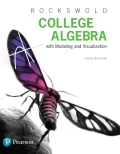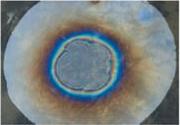
Concept explainers
Extended and Discovery Exercise
Exercises 1- 4: Measuring the thickness of a very thin layer of material can be difficult to do directly. For example. it would be difficult to measure the thickness of an oil film on water or a coat of paint with a ruler. However, it can be done indirectly using the following formula.
That is, the thickness of a thin layer equals the volume of the substance divided by the area that it covers. For example, if a volume of 1 cubic inch of paint is spread over an area of 100 square inches, then the thickness of the paint equals

- Thickness of an Oil Film A drop of oil measuring 0.12 cubic centimeter in volume is spilled onto a lake. The oil spreads out in a circular shape having a diameter of 23 centimeters. Approximate the thickness of the oil film.
- Thickness of Gold Foil A flat, rectangular sheet of gold foil measures 20 centimeters by 30 centimeters and has a mass of 23.16 grams. If 1 cubic centimeter of gold has a mass of 19.3 grams. find the thickness of the gold foil. (Source: U. Haber-Schaim. Introductory Apical Science.)
- Thickness of Cement A 100-foot-long sidewalk is 5 feet wide. If 125 cubic feet of cement are evenly poured to form the sidewalk, find the thickness of the sidewalk.
- Depth of a Lake A lake covers 2.5 X 107 square feet and contains 7.5 X 108 cubic feet of water. Find the average depth of the lake.
Classifying Numbers
Exercises 1-6: Classify the number as one or more of the following: natural number, integer, rational number, or real number.
1.
2. 695,000 (Number of Facebook status updates every 60 seconds)
3. 7.5 (Average number of gallons of water used each minute while taking a shower)
4. 8.4 (Neilsen rating of the TV show Modern Family the week of January 2, 2012)
5. 90
6. -71 (Wind chill when the temperature is -30°F and the wind speed is 40 mi/hr)
Exercises 7-10: Classify each number as one or more of the following: natural number, integer, rational number, or irrational number.
7. p, -3,
8.
9.
10.
l
Want to see the full answer?
Check out a sample textbook solution
Chapter 1 Solutions
EBK COLLEGE ALGEBRA WITH MODELING & VIS
- 20 2. Let A = = [ -2 0 1 3 ] and B = 2 3 -1 2 For each of the following, calculate the product or indicate why it is undefined: (a) AB (b) BAarrow_forwardAnswer the number questions with the following answers +/- 2 sqrt(2) +/- i sqrt(6) (-3 +/-3 i sqrt(3))/4 +/-1 +/- sqrt(6) +/- 2/3 sqrt(3) 4 -3 +/- 3 i sqrt(3)arrow_forward1 Matching 10 points Factor and Solve 1)x3-216 0, x = {6,[B]} 2) 16x3 = 54 x-[3/2,[D]] 3)x4x2-42 0 x= [ +/-isqrt(7), [F] } 4)x+3-13-9x x=[+/-1.[H]] 5)x38x2+16x=0, x = {0,[K}} 6) 2x6-10x-48x2-0 x-[0, [M], +/-isqrt(3)) 7) 3x+2x²-8 x = {+/-i sqrt(2), {Q}} 8) 5x³-3x²+32x=2x+18 x = {3/5, [S]} [B] [D] [F] [H] [K] [M] [Q] +/-2 sqrt(2) +/- i sqrt(6) (-3+/-3 i sqrt(3))/4 +/- 1 +/-sqrt(6) +/- 2/3 sqrt(3) 4 -3 +/- 3 i sqrt(3) [S]arrow_forward
- The only problems I need help with ae the last 8 ones, Thanksarrow_forwardGraph without using the calculator y-1 = | x+4 |arrow_forward9:43 AS く Akbar © Printed in the United States 15) Scale: 1 cmal unit on both axes .ill 64% The graph above shows a straight line QT intersecting the y-axis at T. i State the co-ordinates of T. ii Calculate the gradient of QT 16) iii Determine the equation of QT. A (-1, 9) ||| i L Г (5 marks)arrow_forward
 Trigonometry (MindTap Course List)TrigonometryISBN:9781305652224Author:Charles P. McKeague, Mark D. TurnerPublisher:Cengage Learning
Trigonometry (MindTap Course List)TrigonometryISBN:9781305652224Author:Charles P. McKeague, Mark D. TurnerPublisher:Cengage Learning Algebra: Structure And Method, Book 1AlgebraISBN:9780395977224Author:Richard G. Brown, Mary P. Dolciani, Robert H. Sorgenfrey, William L. ColePublisher:McDougal Littell
Algebra: Structure And Method, Book 1AlgebraISBN:9780395977224Author:Richard G. Brown, Mary P. Dolciani, Robert H. Sorgenfrey, William L. ColePublisher:McDougal Littell Holt Mcdougal Larson Pre-algebra: Student Edition...AlgebraISBN:9780547587776Author:HOLT MCDOUGALPublisher:HOLT MCDOUGAL
Holt Mcdougal Larson Pre-algebra: Student Edition...AlgebraISBN:9780547587776Author:HOLT MCDOUGALPublisher:HOLT MCDOUGAL Elementary Geometry For College Students, 7eGeometryISBN:9781337614085Author:Alexander, Daniel C.; Koeberlein, Geralyn M.Publisher:Cengage,
Elementary Geometry For College Students, 7eGeometryISBN:9781337614085Author:Alexander, Daniel C.; Koeberlein, Geralyn M.Publisher:Cengage, Mathematics For Machine TechnologyAdvanced MathISBN:9781337798310Author:Peterson, John.Publisher:Cengage Learning,
Mathematics For Machine TechnologyAdvanced MathISBN:9781337798310Author:Peterson, John.Publisher:Cengage Learning,





